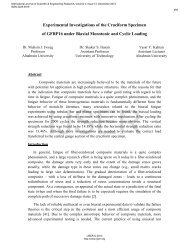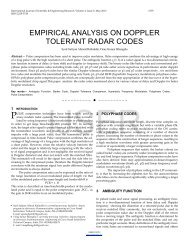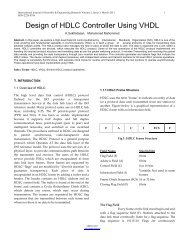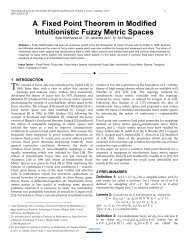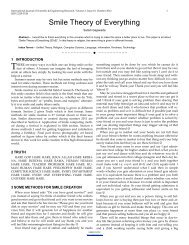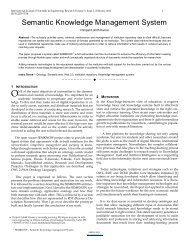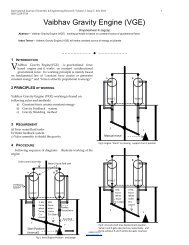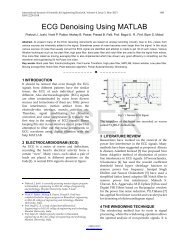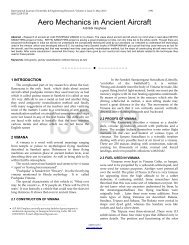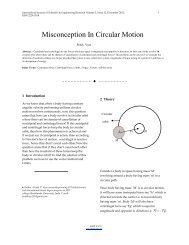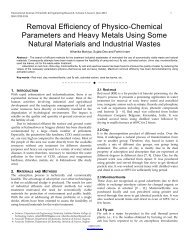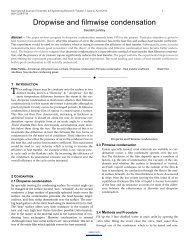Face Detection and Tracking System - International Journal of ...
Face Detection and Tracking System - International Journal of ...
Face Detection and Tracking System - International Journal of ...
Create successful ePaper yourself
Turn your PDF publications into a flip-book with our unique Google optimized e-Paper software.
<strong>International</strong> <strong>Journal</strong> <strong>of</strong> Scientific & Engineering Research Volume 3, Issue 10, October-2012 2<br />
ISSN 2229-5518<br />
2.2 The <strong>Face</strong> <strong>Detection</strong><br />
The basic idea behind the <strong>Face</strong> detection is facial color detection.<br />
We all know that human skin consists <strong>of</strong> a wide range<br />
<strong>of</strong> colors. If by any means we could detect those ranges <strong>of</strong> colors,<br />
we can detect a face. This is the basic idea behind face detection.<br />
But as the range is too high we cannot put all the data<br />
just by coding. So we have to take certain idea from the field<br />
<strong>of</strong> Artificial Intelligence. We developed a Simple algorithm <strong>of</strong><br />
learning. The idea was that we will choose some r<strong>and</strong>om faces<br />
<strong>and</strong> the computer will take their picture, detect the components<br />
<strong>of</strong> their skin color separately as RGB <strong>and</strong> stores those<br />
data in a table known as a Look up table. This look up table is<br />
maintained in a XML file <strong>and</strong> is incorporated into the code by<br />
use <strong>of</strong> a classifier.<br />
After the face is detected by the color threshold, we draw a<br />
rectangle box around the detected face. (In our system, it is a<br />
25,000 line long XML file (Look-up table). So; we ensured the<br />
accuracy as 92 %)This rectangle now becomes our Region <strong>of</strong><br />
Interest (ROI). We store this ROI in a Database, so that later<br />
we can access the database to see the people who came to the<br />
room. At the same time the frames where we get the ROI is<br />
joined to form a High FPS Mpeg Video. As we will send the<br />
video over internet, so we recorded the video in high frame<br />
rate to decrease the video size. But in case <strong>of</strong> face images we<br />
used lossless format .bmp. So, the image size will be increased,<br />
but a lossless image format is always better for a future analysis.<br />
Though the space complexity will increase, but the time<br />
complexity will decrease. And in a security system, system<br />
speed is a notable issue. Detected faces <strong>and</strong> videos are shown<br />
in Fig. 2 <strong>and</strong> Fig. 3 respectively.<br />
Fig. 2. <strong>Tracking</strong> videos<br />
Then from the ROI the centre <strong>of</strong> the face is detected by the<br />
meeting point <strong>of</strong> the diagonals <strong>of</strong> the rectangle box. But this<br />
position is with respect to the ROI <strong>and</strong> not with respect to the<br />
original picture. So we have to again convert them with respect<br />
to the whole frame. After that the modified coordinate is<br />
written in a text file in a queue fashion.<br />
Fig. 3. <strong>Face</strong> is detected through the program running behind<br />
Fig. 1. Detected faces stored as images<br />
2.3 Hardware <strong>and</strong> <strong>Tracking</strong><br />
After detection <strong>of</strong> the face we need to trace that by the<br />
camera. So we set the camera on plate fitted with a stepper<br />
motor at the base. For controlling the motor we build a controller<br />
board with ATMega16 microcontroller, Motor Driver<br />
<strong>and</strong> RS232 USART IC. The motor Driver consisted <strong>of</strong> TIP122<br />
Darlington-Pair Transistors. RS232 is used in order to access<br />
the serial port with the controller.<br />
The tracking part is done in MATLAB. After detection as<br />
mentioned earlier the data is written in a text file. Through<br />
MATLAB we read the data <strong>and</strong> check whether the coordinate<br />
is greater than the screen’s centre. If it is greater then write an<br />
‘R’ in the serial port <strong>and</strong> if it is less we write an ‘L’ in the port.<br />
Now via the microcontroller we are continuously checking the<br />
serial port <strong>and</strong> whenever the USART finds any data in the port<br />
it sends that data to the microcontroller. The Microcontroller is<br />
IJSER © 2012<br />
http://www.ijser.org


